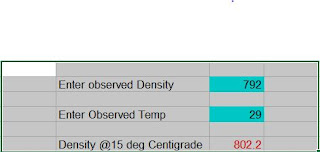- Relationship between Flash Point and Front-end Distillation data of petroleum products, (a Scholarly article)
- Relationship between Flash Point and Front-end Distillation data of petroleum products,
The relationship between Flash Point and Atmospheric front-end Distillation data of petroleum products, normally recorded during the routine testing are correlated during 1986 – 1988 period by a team (S/S RJ Patel, PD Dusane, NS Kamble, SK Shukla at IOC Kandla Laboratory ). The idea was originated from similar literature that time, W.L. Nelson ( Petroleum Engineering, pg 131, edition 1982, initially put forward in year 1944).
Team under the leadership of the author of this blog could
work out a most improved/accurate empirical relationship as given below:
Predicted Abel Flash Point FP = 0.613*IBP + 0.193*T10 - 84.0.
( all temperatures
in deg Centigrade, C ).
Where, FP = Abel Flash Point deg, C
IBP= Initial Boiling Point as per ASTM D86 Distillation &
T10 = ASTM D86 Distillation, 10% recovery temperature
Where, FP = Abel Flash Point deg, C
IBP= Initial Boiling Point as per ASTM D86 Distillation &
T10 = ASTM D86 Distillation, 10% recovery temperature
The empirical formula has been derived by testing and
further revalidated more than 5000 Kerosene, Aviation Turbine fuel, and similar samples from products received at Kandla, which were derived
from a wide range of crudes and refineries from Russia, US, Venezuela,
China, Gulf countries, Singapore etc beside India. The team was benefitted
incidentally since India was importing finished products from a wide
global sources during the period mentioned.
Later on, some other work on the same subject appeared and
one such very reputed reference is found in API correlation (1997 version).
FP = 0.68*T_10%_D86 - 109.6 where FP: flash point
, ºF, T_10%_D86 : ASTM D86 10% temperature , ºF. Also, by D.S.J. Jones
(Elements of Petroleum Processing-Wiley) is: Flash
point = 0.77(ASTM 5% in oF - 150oF).
However, the author claims that the IndianOil Kandla
Laboratory team work is more accurate than the other existing known correlation
equations, though work done much earlier then, with following features:
It is most accurate, 2 parameters ( IBP and 10%T )
have been correlated rather than one. Flash Point of the sample can
be predicted accurately from routine Distillation data. When Distillation data
are very accurate, the flash point worked out is within precision of the test
methods. Also from Flash point, prediction of either IBP or T10 can be made
accurately. This was used extensively for verifying data in many round
robin programmes conducted by IndianOil Laboratories.
Performance of equipment/technicians, indirectly verifying
accuracy of thermometers, test protocol followed by technician etc is possible.
A caution is not out of place that any contaminated samples with volatile
products like gasoline will have error like result.
Author acknowledges other team members for their
contribution for the efforts towards deriving most accurate relationship
equation between Flash point and front end routine distillation data.
Hope the Petroleum technical community will be benefited by use of the
equation.
References :
Key Words : Flash Point Abel, Distillation D-86,
Follow me on twitter @RJPatel13 to get notification when my new post is available in my blog.
****************************************************************************

Comments